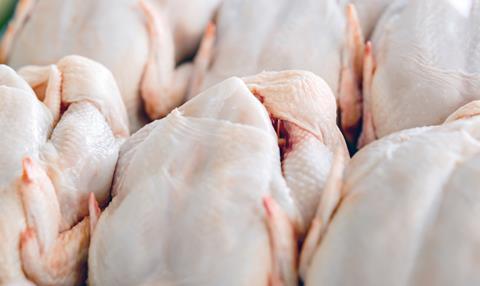SPECIAL FEATURE - Poultry hygiene:
Peter Littleton, technical director of Christeyns Food Hygiene, discusses the key elements and problems associated with hygiene in the poultry processing sector.

“Poultry accounts for just over half of all the meat consumed in the UK.
In 2019, the UK production value of poultry and poultry meat was over £2.7 billion. This translated to an output of 1.94 million metric tons that year with around 570 companies in the UK producing poultry meat in 2019.1
The total manufacturing sales volume for prepared or preserved poultry meat in the United Kingdom in 2019 amounted to approximately 255 thousand tons, including patés and pastes other than in sausage casings or pressed into a sausage shape.
Poultry is therefore big business and as such plays an important role in the food chain. If hygiene measures are not top notch, there could be many consequences, including the presence of pathogenic microorganisms - such as campylobacter, salmonella and listeria, that can have a significant impact on public health.
Quality and safety issues are a huge concern in the poultry industry, and particularly in poultry slaughterhouses and cutting plants, where the implementation of strategies to control pathogenic microorganisms is key to provide safe food for the consumer, as well as in minimising the presence of spoilage microorganisms, which can reduce the products’ shelf life.
TBF® 300 is a ready-to-use product that enables the detection of all kind of biofilms in the food industry.
Poultry meat is a highly perishable food and is an excellent medium for microbial growth. Spoilage microorganisms affect the shelf life of the product when the number of microorganisms per gram in a piece of meat exceeds 1.0 x 105 cfu/cm2. It’s at this point that changes begin to appear in the form of an unpleasant odour, colour alterations, surface viscosity, and the product becomes unacceptable for human consumption.
So, all surfaces through which the product passes must be as hygienic as possible to prevent the transfer of microorganisms.
Biofilm formation also represents a threat to meat safety as many foodborne pathogens can develop biofilms in areas that are difficult to clean and disinfect properly. Their formation depends mainly on the interaction between three components: bacterial cells, adhesion surface and the environment that surrounds the biofilm.
At Christeyns we use technology that quickly and easily detects the presence of biofilms. TBF® 300 is a ready-to-use product that enables the detection of all kind of biofilms in the food industry. Once identified, we recommend that products specifically formulated for the effective and safe removal of biofilms are employed.
Analytical and systematic approaches should be considered to decrease the microbial load and preventive and control strategies should be put in place such as cleaning and disinfection procedures.
We have produced a regime for biofilm identification and removal based on introducing an additional, powerful and verified disinfection stage between the routine detergent and disinfection stages. In this way biofilms can be effectively removed with the minimum of operational disruption and without distributing active biofilm material to other parts of the plant.
The presence of both spoilage and pathogenic microorganisms throughout the production process is continuous. But there are some critical points that can cause cross-contamination such as bird reception in the live bird cages, in the slaughter area, scalding, plucking and evisceration line. This is why analytical and systematic approaches should be considered to decrease the microbial load and preventive and control strategies should be put in place such as cleaning and disinfection procedures.
The kind of organic dirt is different in each part of the slaughterhouse and therefore the chemicals suitable for removing the specific types of dirt present are different.
To eliminate the above-mentioned food hazards, the basis of a cleaning and disinfection procedure should include at least the following steps:
- Removal of the largest particles by means of effective water pressure and mopping. Following this step, walls, equipment and floors should look clean.
- Application of cleaning detergents or detergent- disinfectants intended for food establishments. These help to dislodge any remaining dirt such as particles of grease, and to keep them in suspension or emulsify them. Detergents are dissolved in water and should be used at the correct recommended manufacturer concentration and proper temperature. They can be applied by spraying, immersion or using foam-spraying equipment, although some surfaces with thick layers of stuck on dirt may require manual scrubbing with scouring pads or non-abrasive brushes.
- Rinsing with water to eliminate any remaining dissolved or suspended dirt and leftover detergent.
- Disinfection by spraying all surfaces at the recommended dosage and contact time.
Another essential aspect for the poultry industry is guaranteeing that all personnel accessing the production area also meet the highest personal hygiene standards with the correct clothing and equipment.
Finally, it is crucial to monitor routine cleaning and disinfection on an ongoing basis. This will show that operations have been performed correctly and that the facilities have been effectively cleaned to prevent potential cross-contamination using unique tools such as FreshCheck. But more importantly, it will identify bad practices that may be potential sources of microbiological contamination.
Chicken is a staple food in our diet which makes the poultry industry extremely important in terms of food safety. Achieving the highest level of hygiene in the industry is paramount to ensuring poultry meat quality and safety. In addition, the monitoring of daily hygiene regimes will encourage a sustainable management of resources such as chemicals, water and energy.”
This story was originally published on a previous version of the Meat Management website and so there may be some missing images and formatting issues.












